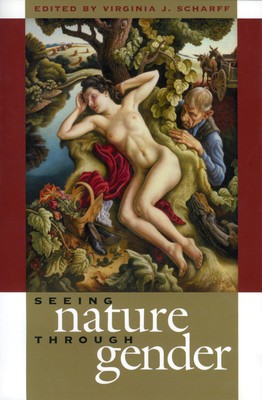
- We will send in 10–14 business days.
- Publisher: University Press Of Kansas
- ISBN-10: 0700612858
- ISBN-13: 9780700612857
- Format: 15.3 x 22.9 x 2.5 cm, softcover
- Language: English
- SAVE -10% with code: EXTRA
Seeing Nature Through Gender (e-book) (used book) | bookbook.eu
Reviews
Description
Environmental history has traditionally told the story of Man and Nature. Scholars have too frequently overlooked the ways in which their predominantly male subjects have themselves been shaped by gender. Seeing Nature through Gender here reintroduces gender as a meaningful category of analysis for environmental history, showing how women's actions, desires, and choices have shaped the world and seeing men as gendered actors as well.
In thirteen essays that show how gendered ideas have shaped the ways in which people have represented, experienced, and consumed their world, Virginia Scharff and her coauthors explore interactions between gender and environment in history. Ranging from colonial borderlands to transnational boundaries, from mountaintop to marketplace, they focus on historical representations of humans and nature, on questions about consumption, on environmental politics, and on the complex reciprocal relations among human bodies and changing landscapes. They also challenge the "ecofeminist" position by challenging the notion that men and women are essentially different creatures with biologically different destinies. Each article shows how a person or group of people in history have understood nature in gendered terms and acted accordingly--often with dire consequences for other people and organisms. Here are considerations of the ways we study sexuality among birds, of William Byrd's masking sexual encounters in his account of an eighteenth-century expedition, of how the ecology of fire in a changing built environment has reshaped firefighters' own gendered identities. Some are playful, as in a piece on the evolution of "snow bunnies" to "shred betties." Others are dead serious, as in a chilling portrait of how endocrine disrupters are reinventing humans, animals, and water systems from the cellular level out. Aiding and adding significantly to the enterprise of environmental history, Seeing Nature through Gender bridges gender history and environmental history in unexpected ways to show us how the natural world can remake the gendered patterns we've engraved on ourselves and on the planet.EXTRA 10 % discount with code: EXTRA
The promotion ends in 16d.22:17:41
The discount code is valid when purchasing from 10 €. Discounts do not stack.
- Publisher: University Press Of Kansas
- ISBN-10: 0700612858
- ISBN-13: 9780700612857
- Format: 15.3 x 22.9 x 2.5 cm, softcover
- Language: English English
Environmental history has traditionally told the story of Man and Nature. Scholars have too frequently overlooked the ways in which their predominantly male subjects have themselves been shaped by gender. Seeing Nature through Gender here reintroduces gender as a meaningful category of analysis for environmental history, showing how women's actions, desires, and choices have shaped the world and seeing men as gendered actors as well.
In thirteen essays that show how gendered ideas have shaped the ways in which people have represented, experienced, and consumed their world, Virginia Scharff and her coauthors explore interactions between gender and environment in history. Ranging from colonial borderlands to transnational boundaries, from mountaintop to marketplace, they focus on historical representations of humans and nature, on questions about consumption, on environmental politics, and on the complex reciprocal relations among human bodies and changing landscapes. They also challenge the "ecofeminist" position by challenging the notion that men and women are essentially different creatures with biologically different destinies. Each article shows how a person or group of people in history have understood nature in gendered terms and acted accordingly--often with dire consequences for other people and organisms. Here are considerations of the ways we study sexuality among birds, of William Byrd's masking sexual encounters in his account of an eighteenth-century expedition, of how the ecology of fire in a changing built environment has reshaped firefighters' own gendered identities. Some are playful, as in a piece on the evolution of "snow bunnies" to "shred betties." Others are dead serious, as in a chilling portrait of how endocrine disrupters are reinventing humans, animals, and water systems from the cellular level out. Aiding and adding significantly to the enterprise of environmental history, Seeing Nature through Gender bridges gender history and environmental history in unexpected ways to show us how the natural world can remake the gendered patterns we've engraved on ourselves and on the planet.

Reviews